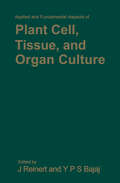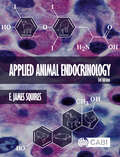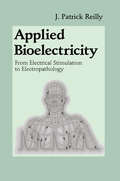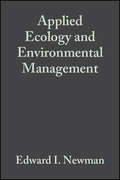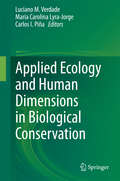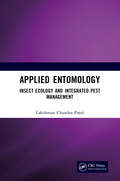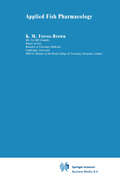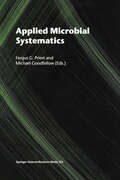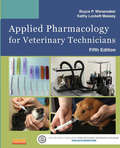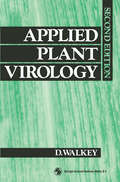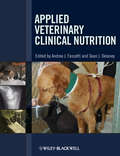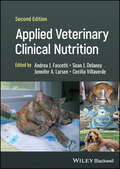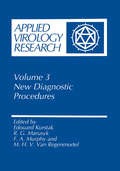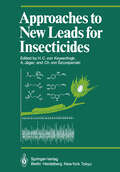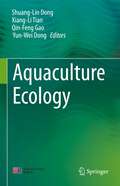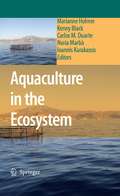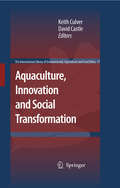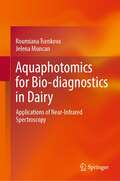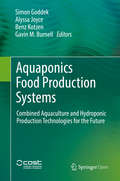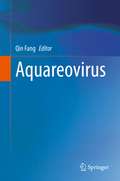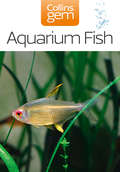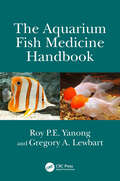- Table View
- List View
Applied and Fundamental Aspects of Plant Cell, Tissue, and Organ Culture
by Jakob Reinert Yashpal S. BajajProgress in the field of plant cell and tissue culture has made this area of research one of the most dynamic and promising not only in plant physiology, cell biology and genetics but also in agriculture, forestry, horticulture and industry. Studies with plant cell cultures clearly have bearing upon a variety of problems as yet unsolved in basic and applied research. This was the compelling reason for assembling such a comprehensive source of information to stimulate students, teachers, and research workers. This book comprises 34 articles on regeneration of plants, vegetative propagation and cloning; haploids; cytology, cytogenetics and plant breeding; protoplasts, somatic hybridization and genetic engineering; plant pathology; secondary products and a chapter on isoenzymes, radiobiology, and cryobiology of plant cells. Particular attention has been paid to modern , fast-growing and fascinating disciplines - e.g. the induction of haploids, somatic hybridization and genetic manipulation by protoplast culture, which possess an enormous potential for plant improvement.
Applied Animal Endocrinology
by E. James SquiresThis book explains the role of hormones in improving and monitoring the production, performance, reproduction, behaviour and health of livestock animals, focusing on cattle, pigs, sheep, horses, poultry and fish. Beginning with the principles of endocrinology and the methods to study endocrine systems, it then covers the different endocrine systems that affect different aspects of animal production and describes how these systems can be manipulated or monitored to advantage. The mechanism of action is covered, and common mechanisms and themes highlighted in order to understand potential methods for altering these systems, and stimulate ideas for the development of new methods. A refreshed, updated resource that highlights new areas of endocrinology with applications in commercial animals, additions to this new edition include: - information on G protein receptors, function of CREB, methods for identification of DNA regulatory sequences and DNA binding proteins, circadian rhythm and the biological clock; - expanded coverage of in vitro models to include 3D cell culture and organ-on-a-chip; - new knowledge on gene editing, antibody production, hormone delivery methods and DNA cloning and sequencing methods; - the role of the gut microbiome, as well as effects of antibiotics and antimicrobials; - skin as an endocrine organ and related information on wool production and endocrine defleecing; - updated information on protocols for assessing endocrine disruptor chemicals. An invaluable text for students of animal science and veterinary medicine, this book also provides a useful resource for those in academia and industry interested in applications of endocrinology in animal production systems.
Applied Bioelectricity: From Electrical Stimulation to Electropathology
by J. Patrick ReillyElectric currents and electromagnetic fields have been applied to biological systems, particularly humans, with both therapeutic and pathological results. This text discusses biological responses to electric currents and electromagnetic fields, including medical applications and shock hazards. It covers fundamental physical and engineering principles of responses to short-term electrical exposure and emphasises human reactions, although animal responses are considered as well, and the treatment covers reactions from the just-detectable to the clearly detrimental. An important new chapter discusses standards for human exposure to electromagnetic fields and electric current and demonstrates how these standards have been developed using the principles treated in earlier chapters.
Applied Ecology and Environmental Management
by Edward I. NewmanThis book explains ways that ecological science can be applied to solving some of the most crucial problems facing our world today. A major theme is how resources can be effectively managed and exploited in as near a sustainable manner as possible. The author draws together, in a single volume, major topics in environmental and resource management that have traditionally been dispersed among several different books. Applied Ecology starts with an analysis of our planet's basic natural resources - energy, water and soil; it moves on to the management of biological resources - fish, grazing lands and forests, and then to pest control and pollution. Finally, the book tackles conservation and management of wild species and the restoration of ecological communities. The second edition of this text has been radically redesigned and rewritten. Each chapter starts with a list of questions, setting out the various fundamental problems to be considered. Interwoven with these practical problems is a clear explanation of the underlying basic science - ecology - studied at scales ranging from global, landscape and ecosystem, down to the population and individual (and even their physiology and genetics). The science is illustrated by examples from every major geographic area of the world. This book is aimed primarily at undergraduate students taking courses in applied ecology, environmental science, environmental management and natural resources management. The author has extensive experience as a university teacher. Like his lectures, this book is scientifically rigorous yet clear and easy to understand. Draws together major topics in environmental and resource management, usually dispersed over many separate books. Questions, summaries and clearly structured chapters enhance usability. Emphasis on clarity and accessibility. Based on a proven and successful course.
Applied Ecology and Human Dimensions in Biological Conservation
by Luciano M. Verdade Maria Carolina Lyra-Jorge Carlos I. PiñaThis book provides both the conceptual basis and technological tools that are necessary to identify and solve problems related to biodiversity governance. The authors discuss intriguing evolutionary questions, which involve the sometimes surprising adaptive capacity of certain organisms to dwell in altered and/or changing environments that apparently lost most of their structure and functionality. Space and time heterogeneities are considered in order to understand the patterns of distribution and abundance of species and the various processes that mold them. The book also discusses at which level—from genes to the landscape, including individuals, populations, communities, and ecosystems—men should intervene in nature in order to prevent the loss of biodiversity.
Applied Entomology: Insect Ecology and Integrated Pest Management
by Lakshman Chandra PatelThe subject of Entomology deals with the scientific study of insects in a diverse manner. It has two parts: - Insect Morphology, Anatomy and Systematic - Insect Ecology and Integrated Pest Management (IPM). This book applies to students, researchers, extension workers, farmers and other stakeholders. Both classroom and field learning are important with this updated information to enhance need-based knowledge and skill. Applied Entomology: Insect Ecology and Integrated Pest Management covers mostly used practical work at the field level apropos Insect Ecology and Integrated Pest Management (IPM). Print edition not for sale in India.
Applied Entomology: Insect Ecology and Integrated Pest Management
by Lakshman Chandra PatelThe subject of Entomology deals with the scientific study of insects in a diverse manner. It has two parts: - Insect Morphology, Anatomy and Systematic - Insect Ecology and Integrated Pest Management (IPM). This book applies to students, researchers, extension workers, farmers and other stakeholders. Both classroom and field learning are important with this updated information to enhance need-based knowledge and skill. Applied Entomology: Insect Ecology and Integrated Pest Management covers mostly used practical work at the field level apropos Insect Ecology and Integrated Pest Management (IPM). Print edition not for sale in India.
Applied Fish Pharmacology (Aquaculture Series #3)
by K.M. Treves-BrownAs aquaculture continues to expand there is a need for greater knowledge of medicinal treatments both for the prevention and treatment of disease and for the economic husbandry of fish. This book, the first of its kind, is written for a worldwide readership. It is a reference manual for anyone involved in the selection of medicines for administration to fish. It will also be useful to administrators concerned with the legal control of aquaculture. The first part covers issues which affect all medicine's methods of administering drugs to fish, the various aspects of safety and the relevant legislation in countries with important aquacultural industries. Subsequent parts review the range of available medicinal substances and present current knowledge of the pharmacology and methods of use for each. Particular attention is given to safety issues - for the fish, for the person administering the medicine, for the consumer of medicated fish and for the environment.
Applied Microbial Systematics
by F. G. Priest Michael GoodfellowModern approaches to microbial classification and identification, particularly those based on nucleic acid analysis, have raised the awareness and interest of microbiologists in systematics during the past decade. The extended scope of the subject has revolutionized microbial ecology with the demonstration of uncultivable microorganisms as a major component of the biosphere and evolution, with the ribosomal RNA phylogenetic tree as the basis of current classifications. However, advances in microbial systematics have also had enormous impact on other, diverse aspects of microbiology such as animal pathogenicity, plant-microbe interactions and relationships with food. In this book, we survey and discuss in depth the contribution of modern taxonomic approaches to our understanding of the microbiology of these various systems. The book does not concentrate on methods - these have been well reported elsewhere - instead it provides a unique insight into the application and value of modern systematics in diverse branches of microbiology. It will be of value to microbiologists at both research and technical levels who need to appreciate the range of organisms with which they work and the diversity within them. It will also be of value to teachers and students of microbiology courses who want to understand how systematics can enhance microbiology beyond the routine of classification, nomenclature, and identification.
Applied Pharmacology for Veterinary Technicians - E-Book
by Boyce P. Wanamaker Kathy MasseyNow in full color, Applied Pharmacology for Veterinary Technicians, 5th Edition shows you how to administer prescribed drugs to animals, calculate drug dosages accurately, and instruct clients about side effects and precautions. Coverage of drug information includes pharmacokinetics, pharmacodynamics, clinical uses, dosage forms, and adverse effects. An Evolve companion website enhances the book with narrated videos demonstrating drug administration techniques, animations of pharmacologic processes, dosage calculation exercises, and much more. Written by veterinary technology experts Boyce Wanamaker and Kathy Lockett Massey, this resource provides the pharmacology knowledge you need to succeed as a vet tech!Illustrated, step-by-step procedures demonstrate proper administration techniques for common drug forms.Body systems organization provides a logical sequence of study, followed by anti-infectives, antiparasitics, anti-inflammatory agents, and others.Dosage calculation exercises provide practice immediately after new information is presented.Proprietary drug names are listed with generic drug names, highlighting drugs with generic options.Review questions reinforce understanding of key concepts, with answers located in the back of the book.An Evolve companion website provides drug administration videos, drug calculators with accompanying word problems, photos of drug labels, animations of pharmacologic processes, and dosage calculation exercises.Key terms, chapter outlines, and learning objectives at the beginning of each chapter make studying easier.Technician Notes provide useful hints and important reminders to help you avoid common errors and increase your efficiency.UNIQUE Pharmacy Management and Inventory Control chapter offers practical tips relating to vendor types, communicating with sales representatives, and using veterinary practice management software.Now in full color, UPDATED drug information keeps you current with the latest pharmacologic agents and their uses, adverse side effects, and dosage forms.NEW coverage of stem cell treatment in Immunologic Drugs chapter addresses scientific advances in this area.UPDATED fluid therapy chapter explains the role of parenteral fluids, oral fluids, and nutritional products in drug therapy.
Applied Plant Virology
by D.G. WalkeyFor the past twenty years I have worked as an applied plant virologist, attempting to identify and control virus diseases in field crops. During the last ten years it has been my privilege to present short courses in plant virology to final-year students studying plant pathology, micro biology and general botany. Throughout the period I have been lecturing, it has been possible to recommend several excellent 'library' books for further reading in plant virology, but there has been no publication covering applied plant virology that a student might consider purchasing. With teaching requirements in mind this book has been written to provide a concise introduction to applied plant virology based on the experiences I have gained working on virus diseases, both in an applied laboratory and in the field. The text concentrates on introducing the reader to aspects of plant virology that would be encountered every day by an applied virologist trying to identify viruses and develop control measures for virus diseases of crop plants. Although a brief introduction to virus structure and its terminology is given in the opening chapter of the book, no attempt is made to cover in detail the more fundamental aspects of virus structure, biochemistry and replication. Similarly, the symptoms caused by individual viruses are not described, although the various types of symptoms that plant viruses cause and which might be encountered by a student or research worker are described.
Applied Veterinary Clinical Nutrition
by Andrea J. Fascetti Sean J. DelaneyApplied Veterinary Clinical Nutrition provides current, clinically relevant nutritional advice intended for use in daily canine and feline practice. Highly practical, the book emphasizes solutions for integrating nutrition into clinical practice, with introductory chapters covering the foundation and science behind the recommendations and extensive references for further reading. Written by a group of leading veterinary nutritionists, Applied Veterinary Clinical Nutrition is a valuable resource on the principles of animal nutrition and feeding practices in healthy or diseased dogs and cats. The book begins with an overview of basic nutrition, energy requirements, and the basics of product guides, pet foods, home-prepared diets and dietary supplements. Subsequent chapters delve into feeding the healthy dog and cat, nutrition for weight management, and nutritional principles for a variety of diseases, with the final chapters covering enteral and parenteral nutrition. Applied Veterinary Clinical Nutrition is a daily reference for veterinary practitioners, students, and residents seeking authoritative information on feeding animals.
Applied Veterinary Clinical Nutrition
by Andrea J. Fascetti Sean J. DelaneyApplied Veterinary Clinical Nutrition provides current, clinically relevant nutritional advice intended for use in daily canine and feline practice. Highly practical, the book emphasizes solutions for integrating nutrition into clinical practice, with introductory chapters covering the foundation and science behind the recommendations and extensive references for further reading. Written by a group of leading veterinary nutritionists, Applied Veterinary Clinical Nutrition is a valuable resource on the principles of animal nutrition and feeding practices in healthy or diseased dogs and cats. The book begins with an overview of basic nutrition, energy requirements, and the basics of product guides, pet foods, home-prepared diets and dietary supplements. Subsequent chapters delve into feeding the healthy dog and cat, nutrition for weight management, and nutritional principles for a variety of diseases, with the final chapters covering enteral and parenteral nutrition. Applied Veterinary Clinical Nutrition is a daily reference for veterinary practitioners, students, and residents seeking authoritative information on feeding animals.
Applied Veterinary Clinical Nutrition
by Andrea J. Fascetti Sean J. Delaney Jennifer A. Larsen Cecilia VillaverdeApplied Veterinary Clinical Nutrition Well-referenced clinical resource for canine and feline nutrition, with expansions throughout and two new chapters covering birds and small mammals. Fully revised to reflect new advances and information throughout, the Second Edition of Applied Veterinary Clinical Nutrition presents current, authoritative information on all aspects of small companion animal nutrition. The book provides clinically oriented solutions for integrating nutrition into clinical practice, with introductory chapters covering the foundation and science behind the recommendations and extensive references for further reading in every chapter. With contributions from more than 25 leading veterinary nutritionists, Applied Veterinary Clinical Nutrition covers topics such as: Integration of nutrition into clinical practice, basic nutrition, energy requirements, and pet food regulations in North America and Europe that also apply to many other regions Using and reviewing pet food labels and product guides, feeding the healthy dog and cat, and abridged clinical nutrition topics for companion avian species & small mammals Commercial and home-prepared diets, and nutritional management of body weight and orthopedic, skin, and gastrointestinal diseases Nutritional management of exocrine, hepatobiliary, kidney, lower urinary tract, endocrine, cardiovascular, and oncological diseases as well as enteral and parenteral nutrition A valuable resource on the principles of small animal nutrition and feeding practices in health or disease, Applied Veterinary Clinical Nutrition is a widely trusted and practical daily reference for veterinary practitioners including specialists, residents, and students seeking expert information on feeding their canine, feline, avian, and small mammalian patients.
Applied Veterinary Clinical Nutrition
by Andrea J. Fascetti Sean J. Delaney Jennifer A. Larsen Cecilia VillaverdeApplied Veterinary Clinical Nutrition Well-referenced clinical resource for canine and feline nutrition, with expansions throughout and two new chapters covering birds and small mammals. Fully revised to reflect new advances and information throughout, the Second Edition of Applied Veterinary Clinical Nutrition presents current, authoritative information on all aspects of small companion animal nutrition. The book provides clinically oriented solutions for integrating nutrition into clinical practice, with introductory chapters covering the foundation and science behind the recommendations and extensive references for further reading in every chapter. With contributions from more than 25 leading veterinary nutritionists, Applied Veterinary Clinical Nutrition covers topics such as: Integration of nutrition into clinical practice, basic nutrition, energy requirements, and pet food regulations in North America and Europe that also apply to many other regions Using and reviewing pet food labels and product guides, feeding the healthy dog and cat, and abridged clinical nutrition topics for companion avian species & small mammals Commercial and home-prepared diets, and nutritional management of body weight and orthopedic, skin, and gastrointestinal diseases Nutritional management of exocrine, hepatobiliary, kidney, lower urinary tract, endocrine, cardiovascular, and oncological diseases as well as enteral and parenteral nutrition A valuable resource on the principles of small animal nutrition and feeding practices in health or disease, Applied Veterinary Clinical Nutrition is a widely trusted and practical daily reference for veterinary practitioners including specialists, residents, and students seeking expert information on feeding their canine, feline, avian, and small mammalian patients.
Applied Virology Research: New Diagnostic Procedures (Applied Virology Research #3)
by Edouard KurstakVolume 3 is devoted to the latest diagnostic technology for virus diseases, particularly molecular methodologies.
Approaches to New Leads for Insecticides (Proceedings in Life Sciences)
by Harald C. V. Keyserlingk Albert Jäger Christoph V. SzczepanskiAquaculture Ecology
by Shuang-Lin Dong Xiang-Li Tian Qin-Feng Gao Yun-Wei DongThis book introduces aquaculture ecology as a science of the interaction between commercial aquatic organisms as well as their farming activities and the environment, including the rationales of building and management of aquaculture systems. This book covers productivity and carrying capacity, effects of cyclical fluctuation of environmental factors on aquatic organisms, biological control of water quality, structural optimization of aquaculture systems and ecological prevention of disease. In the last chapter, aquaculture production systems are introduced from multiple perspectives.This book has been designed to provide a stimulating and informative text for researchers in aquaculture, fisheries as well as hydrobiology.
Aquaculture in the Ecosystem
by Marianne Holmer Kenny Black Carlos M. Duarte Nuria Marbà Ioannis KarakassisThis book provides a scientific forecast of development in aquaculture with a focus on the environmental, technological, social and economic constraints that need to be resolved to ensure sustainable development of the industry and allow the industry to be able to feed healthy seafood products to future generations. The chapters discuss the most critical bottlenecks of the development. They encompass subjects of understanding the environmental impacts, the current state-of-the-art in monitoring programs and in coastal zone management, the important interactions between wild and cultured organisms including release of non-native species into the wild.
Aquaculture, Innovation and Social Transformation (The International Library of Environmental, Agricultural and Food Ethics #17)
by Keith Culver David CastleKeith Culver and David Castle Introduction Aquaculture is at the leading edge of a surprisingly polarized debate about the way we produce our food. According to the United Nations Food and Agriculture Organization, aquaculture production has increased 8. 8% per year since 1970, far surpassing productivity gains in terrestrial meat production at 2. 8% in the same period (FAO 2007). Like the ‘green revolution’ before it, the ‘blue revolution’ in aquaculture promises rapidly increased productivity through technology-driven - tensi?cation of aquaculture animal and plant production (Costa-Pierce 2002; The Economist 2003). Proponents of further aquaculture development emphasize aq- culture’s ancient origins and potential to contribute to global food security d- ing an unprecedented collapse in global ?sheries (World Fish Center; Meyers and Worm 2003; Worm et al. 2006). For them, technology-driven intensi?cation is an - dinary and unremarkable extension of past practice. Opponents counter with images of marine and freshwater environments devastated by intensive aquaculture pr- tices producing unsustainable and unhealthy food products. They view the promised revolutionasascam,nothingmorethanclever marketingbypro?t-hungry ?shfa- ers looking for ways to distract the public from the real harms done by aquaculture. The stark contrast between proponents and opponents of modern aquaculture recalls decades of disputes about intensive terrestrial plant and animal agriculture, disputes whose vigor shows that the debate is about much more than food production (Ruse and Castle 2002).
Aquaphotomics for Bio-diagnostics in Dairy: Applications of Near-Infrared Spectroscopy
by Roumiana Tsenkova Jelena MuncanThis book is the result of more than 20 years of experience in working with near-infrared spectroscopy for raw milk analysis. The totality of this work presents extensive possibilities for milk spectral measurements that can be carried out in dairy. Moving beyond the standard milk components such as fat, protein, or lactose, this book presents near-infrared spectroscopy as a method that can also be used in disease diagnostics. The measurements and experimental results presented here are all based on the utilization of usually neglected near-infrared regions—regions with strong absorbance of water. The author has found the water – light interaction discussed to be an immensely rich source of information, not only on milk composition but also on the physiological status of the animals involved. A special section of the book is dedicated to exploration of potential interfering factors that may influence the analysis and contribute to the robustness of the models. The research described in this book served as a basis for the development of the novel discipline aquaphotomics and is of interest to anyone working in this field.
Aquaponics Food Production Systems: Combined Aquaculture and Hydroponic Production Technologies for the Future
by Simon Goddek Alyssa Joyce Benz Kotzen Gavin M. BurnellThis open access book, written by world experts in aquaponics and related technologies, provides the authoritative and comprehensive overview of the key aquaculture and hydroponic and other integrated systems, socio-economic and environmental aspects. Aquaponic systems, which combine aquaculture and vegetable food production offer alternative technology solutions for a world that is increasingly under stress through population growth, urbanisation, water shortages, land and soil degradation, environmental pollution, world hunger and climate change.
Aquareovirus
by Qin FangAquareoviruses cause infection in bony fish and shellfish and thus, constitute a significant threat to aquaculture industries worldwide. Aquareoviruses, belonging to the family Reoviridae, have genomes consisting of 11 segments of double-stranded RNA contained within a core (T = 1) surrounded by a double-layered icosahedral capsid with a T = 13 symmetry in general. These viruses not only physically resemble mammalian orthoreoviruses, but also show the highest amino acid identity. More than hundred aquareoviruses have been isolated from both saline water and freshwater origins; however, literary sources elucidating aquareovirus biology are very limited. Given the increasing pace of discovery, it is imperative to make a clear, systematic filing of key aspects of aquareoviruses. Therefore, the aim of writing this book is to provide insights into the molecular mechanisms of evolution, pathogenesis, and host response in aquareovirus infection. This book offers a state-of-the-art report on recent discoveries concerning the aquareovirus genome evolution, gene encoded protein functions, and pathogenesis by comparison with its sister genus Orthoreovirus, including avian and mammalian reoviruses. It mainly focuses on advances made over the past 30 years in research on the general and molecular biology, protein structure and function, infection and replication, epidemiology and diagnosis, immunological prevention and medical treatment, and host antiviral immunity against aquareovirus infection. This book will help curious graduate students or interested researchers acquire an overall picture of aquareovirus infection and pathogenesis, as well as yield benefits in fisheries to better prevent and control diseases caused by aquareovirus infection.
Aquarium Fish (Collins Gem)
by CollinsThis handy, pocket-sized guide is essential reading for anyone who owns, or is thinking of investing in, an aquarium. It’s packed with colour photographs and provides all the information you need in a concise and accessible format.
The Aquarium Fish Medicine Handbook
by Roy P.E. Yanong Gregory A. LewbartPracticing veterinarians, veterinary technicians, professional aquarists, fish researchers, and tropical fish hobbyists will find this thorough yet concise handbook a complete how-to guide for keeping fish under human care healthy and thriving. Whether you're new to fish medicine and husbandry or an expert in the field, there is valuable information within these pages for you. The book is arranged in a logical order so that readers can quickly and efficiently find the information they seek. The book is filled with valuable and applicable information on dozens of topics including how to manage aquatic life support systems for fish, history taking, natural history, anatomy, physiology, diagnostic techniques, anesthesia, analgesia, and surgery. Virtually all of the most important ornamental fish pathogens, including viruses, bacteria, fungi, and parasites, are described and richly illustrated. There are also sections on fish welfare and conservation.While there are many books on the market that explore the topics of ornamental fish health and care, none provide the amount of helpful information and resources in such a small, affordable package.
